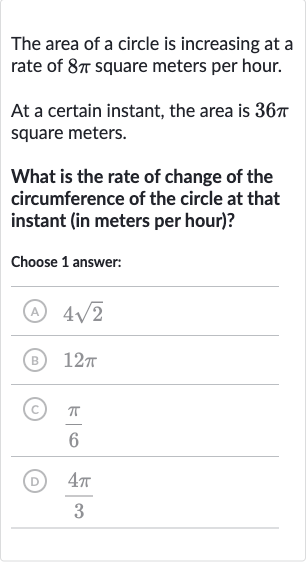AI tutor
Welcome to Bytelearn!
Let’s check out your problem:

The area of a circle is increasing at a rate of square meters per hour.At a certain instant, the area is square meters.What is the rate of change of the circumference of the circle at that instant (in meters per hour)?Choose answer:(A) (B) (C) (D)
Full solution
Q. The area of a circle is increasing at a rate of square meters per hour.At a certain instant, the area is square meters.What is the rate of change of the circumference of the circle at that instant (in meters per hour)?Choose answer:(A) (B) (C) (D)
- Find Radius of Circle: First, let's find the radius of the circle using the area formula . We have , so .
- Calculate Circumference: Divide both sides by to get . Then take the square root of both sides to find the radius meters.
- Use Rate of Change Formula: Now, let's find the circumference using the formula . Plugging in , we get meters.
- Solve for : To find the rate of change of the circumference, we'll use the relationship between the rate of change of the area and the rate of change of the radius. Since , and , we can write .
- Calculate : We know and , so we can solve for : . Simplify to get meters per hour.
- Calculate : We know and , so we can solve for : . Simplify to get meters per hour.Finally, the rate of change of the circumference () is given by . Plug in to get meters per hour.
More problems from Area of quadrilaterals and triangles: word problems
QuestionGet tutor help
QuestionGet tutor help
QuestionGet tutor help
QuestionGet tutor help
QuestionGet tutor help
QuestionGet tutor help
QuestionGet tutor help
